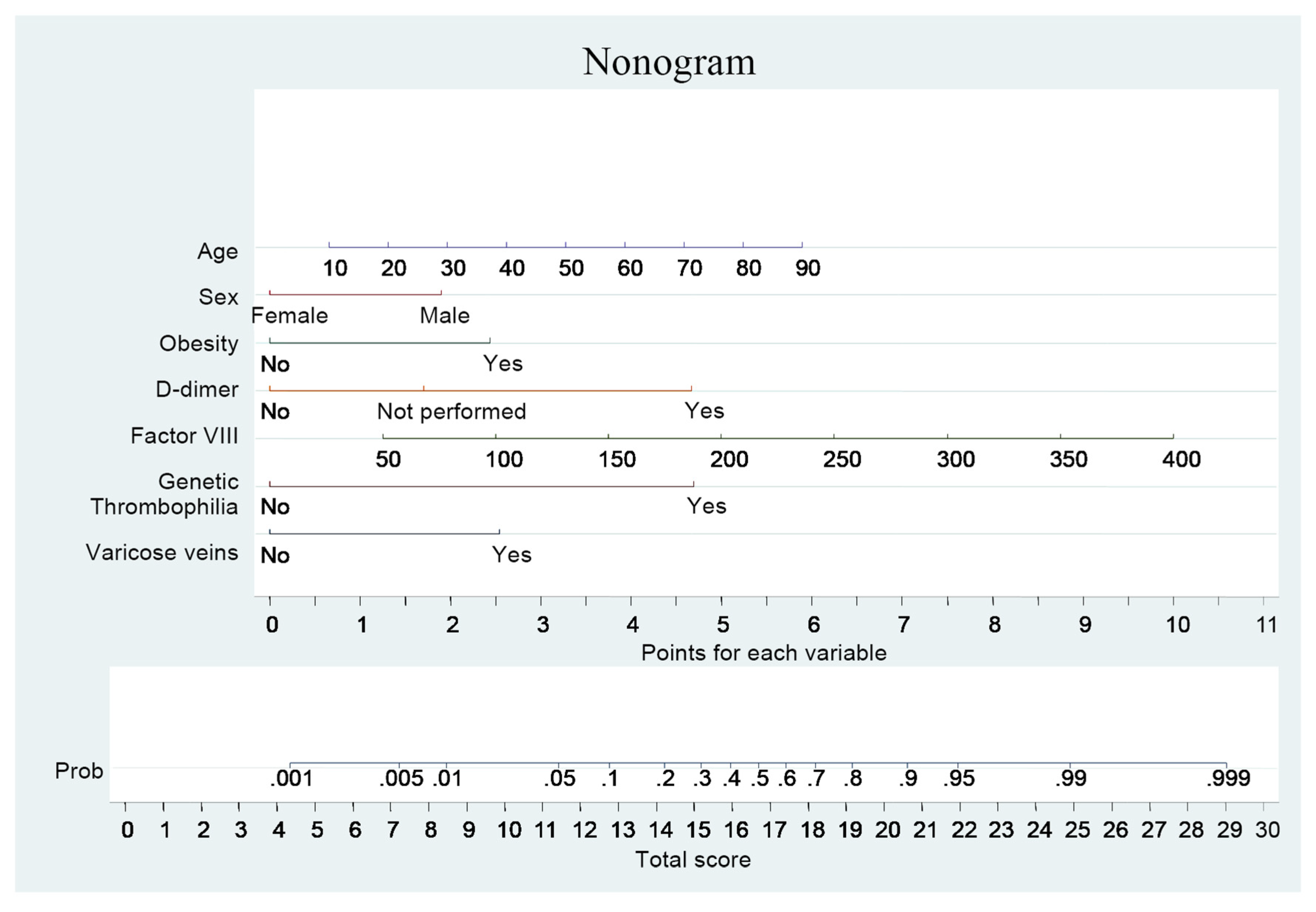Predicting Recurrence after a First Unprovoked Venous Thromboembolism: Retrospective Validation of the DAMOVES Score †
Abstract
:1. Introduction
2. Materials and Methods
3. Results
4. Discussion
5. Conclusions
Author Contributions
Conflicts of Interest
References
- Prandoni, P.; Noventa, F.; Ghirarduzzi, A.; Pengo, V.; Bernardi, E.; Pesavento, R.; Iotti, M.; Tormene, D.; Simioni, P.; Pagnan, A. The risk of recurrent venous thromboembolism after discontinuing anticoagulation in patients with acute proximal deep vein thrombosis or pulmonary embolism. A prospective cohort study in 1626 patients. Haematologica 2007, 92, 199–205. [Google Scholar] [CrossRef] [PubMed]
- Kearon, C.; Akl, E.A.; Ornelas, J.; Blaivas, A.; Jimenez, D.; Bounameaux, H.; Huisman, M.; King, C.S.; Morris, T.A.; Sood, N.; et al. Antithrombotic therapy for VTE disease: CHEST guideline and expert panel report. Chest 2016, 149, 315–352. [Google Scholar] [CrossRef] [PubMed]
- Rodger, M.A.; Kahn, S.R.; Wells, P.S.; Anderson, D.A.; Chagnon, I.; Le Gal, G.; Solymoss, S.; Crowther, M.; Perrier, A.; White, R.; et al. Identifying unprovoked thromboembolism patients at low risk for recurrence who can discontinue anticoagulant therapy. CMAJ 2008, 179, 417–426. [Google Scholar] [CrossRef] [PubMed]
- Tosetto, A.; Iorio, A.; Marcucci, M.; Baglin, T.; Cushman, M.; Eichinger, S.; Palareti, G.; Poli, D.; Tait, R.C.; Douketis, J. Predicting disease recurrence in patients with previous unprovoked venous thromboembolism: A proposed prediction score (DASH). J. Thromb. Haemost. 2012, 10, 1019–1025. [Google Scholar] [CrossRef] [PubMed]
- Eichinger, S.; Heinze, G.; Jandeck, L.M.; Kyrle, P.A. Risk assessment of recurrence in patients with unprovoked deep vein thrombosis or pulmonary embolism: The Vienna prediction model. Circulation 2010, 121, 1630–1636. [Google Scholar] [CrossRef] [PubMed]
- Franco Moreno, A.I.; García Navarro, M.J.; Ortiz Sánchez, J.; Martín Díaz, R.M.; Madroñal Cerezo, E.; de Ancos Aracil, C.L.; Cabello Clotet, N.; Perales Fraile, I.; Gimeno García, S.; Montero Hernández, C.; et al. A risk score for prediction of recurrence in patients with unprovoked venous thromboembolism (DAMOVES). Eur. J. Intern. Med. 2016, 29, 59–64. [Google Scholar] [CrossRef] [PubMed]

| Variables | Original (n = 398) | External Validation | p-Value | ||
|---|---|---|---|---|---|
| All (n = 121) | Lower-Risk Patients (n = 35) | Higher-Risk Patients (n = 86) | |||
| n (%) or Median (Interquartile Range) | |||||
| Age (years) | 1.04 (1.01; 1.07) | 72.0 (69.0; 79.8) | 69.0 (62.0; 77.0) | 78.0 (69.0; 81.0) | 0.04 |
| Male sex | 2.89 (1.21; 6.90) | 81.0 (66.94) | 12.0 (34.28) | 69.0 (80.23) | <0.01 |
| Obesity (BMI a ≥ 30 kg/m2) | 3.92 (1.75; 8.75) | 78.0 (64.46) | 8.0 (22.85) | 70.0 (81.39) | <0.01 |
| Elevated D-dimer levels during AC b | 13.66 (4.74; 39.37) | 69.0 (57.02) | 5.0 (14.28) | 64.0 (74.41) | <0.01 |
| Factor VIII coagulant activity | 1.01 (1.00; 1.02) | 128.0 (96; 181) | 135.0 (96; 151) | 171.0 (124; 181) | <0.01 |
| Genetic thrombophilia c | 13.86 (5.87; 32.75) | 66.0 (54.54) | 13.0 (37.14) | 53.0 (61.62) | <0.01 |
| Varicose veins | 4.14 (1.81; 9.43) | 40.0 (33.05) | 11.0 (31.42) | 29.0 (33.72) | 0.20 |
Publisher’s Note: MDPI stays neutral with regard to jurisdictional claims in published maps and institutional affiliations. |
© 2018 by the authors. Licensee MDPI, Basel, Switzerland. This article is an open access article distributed under the terms and conditions of the Creative Commons Attribution (CC BY) license (https://creativecommons.org/licenses/by/4.0/).
Share and Cite
Moreno, A.I.F.; Navarro, M.J.G.; Aracil, C.L.D.A.; García, A.G.; Hernández, C.M.; Martínez, A.V.; Mateo, V.P.; Sánchez, J.O.; Acevedo, I.C.S.; Díaz, R.M.; et al. Predicting Recurrence after a First Unprovoked Venous Thromboembolism: Retrospective Validation of the DAMOVES Score. Proceedings 2018, 2, 528. https://doi.org/10.3390/proceedings2090528
Moreno AIF, Navarro MJG, Aracil CLDA, García AG, Hernández CM, Martínez AV, Mateo VP, Sánchez JO, Acevedo ICS, Díaz RM, et al. Predicting Recurrence after a First Unprovoked Venous Thromboembolism: Retrospective Validation of the DAMOVES Score. Proceedings. 2018; 2(9):528. https://doi.org/10.3390/proceedings2090528
Chicago/Turabian StyleMoreno, A. I. Franco, M. J. García Navarro, C. L. De Ancos Aracil, A. Gimeno García, C. Montero Hernández, A. Villa Martínez, V. Piedrafita Mateo, J. Ortiz Sánchez, I. C. Sanz Acevedo, R. Martín Díaz, and et al. 2018. "Predicting Recurrence after a First Unprovoked Venous Thromboembolism: Retrospective Validation of the DAMOVES Score" Proceedings 2, no. 9: 528. https://doi.org/10.3390/proceedings2090528
APA StyleMoreno, A. I. F., Navarro, M. J. G., Aracil, C. L. D. A., García, A. G., Hernández, C. M., Martínez, A. V., Mateo, V. P., Sánchez, J. O., Acevedo, I. C. S., Díaz, R. M., & Giardín, J. M. R. (2018). Predicting Recurrence after a First Unprovoked Venous Thromboembolism: Retrospective Validation of the DAMOVES Score. Proceedings, 2(9), 528. https://doi.org/10.3390/proceedings2090528




